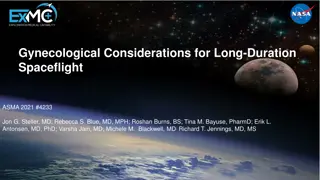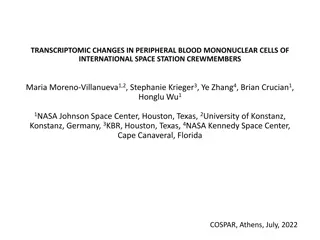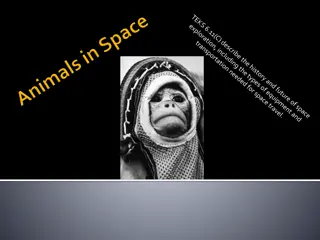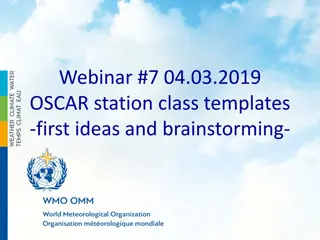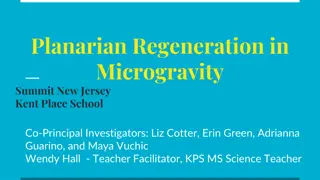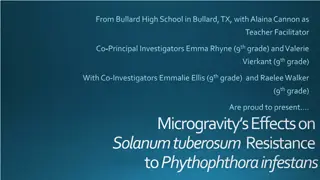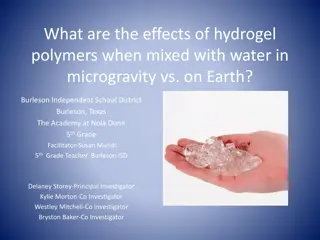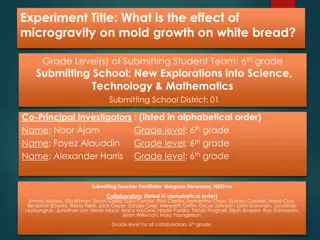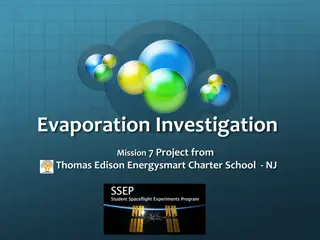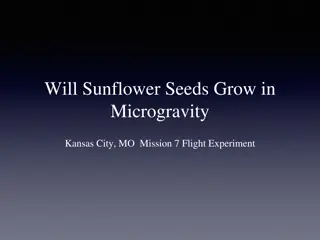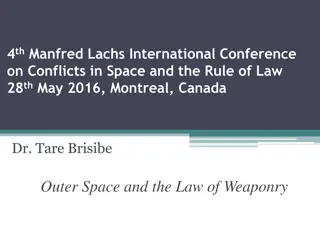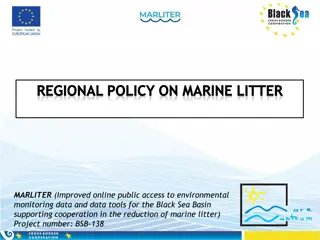Investigating Microgravity Effects on Marine Actinobacteria in the International Space Station
Study focuses on the behavior and development of Marine Actinobacteria in microgravity conditions aboard the International Space Station. Key aspects include growth rate, antibiotic production, and impact of microgravity on actinobacteria. Hypothesis suggests minimal effect on actinobacteria in microgravity, emphasizing their potential as reliable organisms for space exploration experiments. Variables such as gravity, radiation, and antibiotic production are explored in controlled environments.
Download Presentation

Please find below an Image/Link to download the presentation.
The content on the website is provided AS IS for your information and personal use only. It may not be sold, licensed, or shared on other websites without obtaining consent from the author.If you encounter any issues during the download, it is possible that the publisher has removed the file from their server.
You are allowed to download the files provided on this website for personal or commercial use, subject to the condition that they are used lawfully. All files are the property of their respective owners.
The content on the website is provided AS IS for your information and personal use only. It may not be sold, licensed, or shared on other websites without obtaining consent from the author.
E N D
Presentation Transcript
Soil System Sciences Microbial growth, turnover and functioning in soils: modelling and experimental advances Investigation of the growth rate and antibiotic production of Marine Actinobacteria in the International Space Station Marialina Tsinidis1and Manolis Simigdalas2 Scientific Image and Illustration Software | BioRender 1University of Glasgow , Glasgow, United Kingdom of Great Britain England, Scotland, Wales (m.tsinidi@gmail.com) 2Heriot Watt University, Edinburgh, United Kingdom of Great Britain England, Scotland, Wales (manolis.symigdalas@gmail.com) Key Words: Marine Actinobacteria, Astrobiology, Space Medicine, ISS Space Line M
Research Questions Is microgravity capable of affecting the behavior and development of actinobacteria (actinomycetes)?
Background Information Characteristics Gram-positive bacteria high guanine and cytosine contents in DNA include some of the most common soil, freshwater, and marine type Play an important role in decomposition of organic materials, such as cellulose and chitin, thereby playing a vital part in organic matter turnover and carbon cycle, replenishing the supply of nutrients in the soil, and is an important part of humus formation (Anandan, Dharumadurai and Manogaran, 2016).
Experiment Hypothesis The actinobacteria might face a little to none affection during their presence in microgravity, which will prove that bacteria in general are ideal organisms for transportation through space, making them reliable for space exploration and experiments The researcher s hypothesis is that the microgravity will have no effect on the viscosity of the liquid agar and actinobacteria.
Variables Independent Variables -Gravity -Radiation Dependent Variables -Rate of development and behavior change of actinobacteria in microgravity. -Antibiotics production Controlled Variables (Constant) The Substance of Actinobacteria which will not be mixed with any other substance and will not be transferred to any other than the controlled environment Control of Variables -Temperature -Volume of Substances -Volume of Substances mixed (Actinobacteria substance/Antibiotic Substance)
Materials Materials for the first research question Category 1: Earth Apparatus which will be used for the experimentation required before and after the launch in order to compare the substances before and after exposure to microgravity. Substance of Actinobacteria Casein Agar Microscope Pipettes Beaker 100ml Gloves Goggles Cotton tipped swabs Category 2: Space Apparatus, which will be necessary for the activation, mixture and storage of the substances in Space. MixStix tubes (and their associated materials) Substance of Actinobacteria Materials for the second research question Mixstix Ball
Further Steps The researcher aims to test the antibiotic production of the actinobacteria that travelled to the ISS as compared to the ones in the lab. Since this type of bacteria can produce antibiotics, which is useful in medicine, the effects of microgravity on the antibiotic production could be investigated which is useful for astronauts. The aim is to create a mathematical model to predict the antibiotic production based on the growth rate.
Soil System Sciences Microbial growth, turnover and functioning in soils: modelling and experimental advances Investigation of the growth rate and antibiotic production of Marine Actinobacteria in the International Space Station Marialina Tsinidis1 and Manolis Simigdalas2 1University of Glasgow , Glasgow, United Kingdom of Great Britain England, Scotland, Wales (m.tsinidi@gmail.com) 2Heriot Watt University, Edinburgh, United Kingdom of Great Britain England, Scotland, Wales (manolis.symigdalas@gmail.com) Key Words: Marine Actinobacteria, Astrobiology, Space Medicine, ISS Space Line M
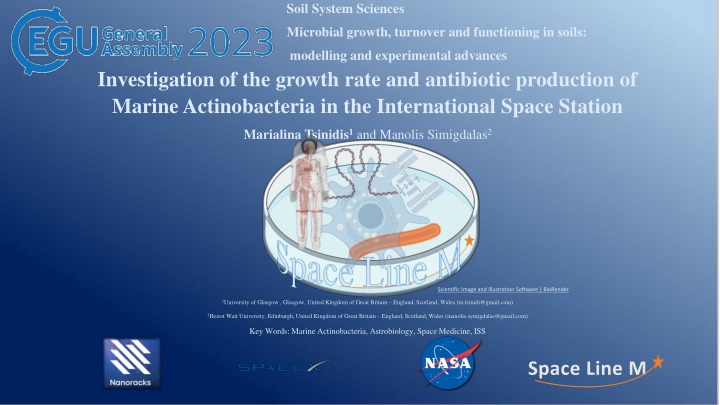


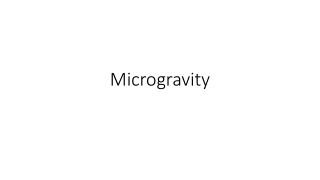
![[PDF⚡READ❤ONLINE] The International Space Station: Building for the Future (Spri](/thumb/21686/pdf-read-online-the-international-space-station-building-for-the-future-spri.jpg)

